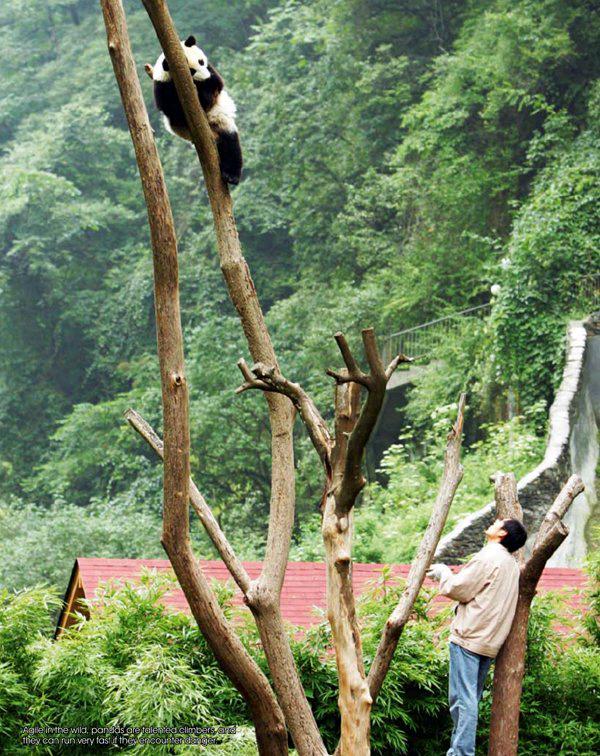Panda Roll Call
by+Yong+Xingzhong

Search for Pandas
Chen Bin heads a group that investigates Piankou Nature Reserve in northern Sichuan Province, specializing in searching for wild pandas as well as recording important information on the health of their habitats, other animals, and man-made interference. He is one of the 2,000 participants from provinces of Sichuan, Shaanxi, and Gansu, who investigate an area of 4.36 million hectares.
It is difficult to encounter wild pandas unless they are injured or sick. Investigators primarily search for their droppings, which serve as the best evidence to measure the panda population. Those unfamiliar with panda excrement could hardly imagine its appearance: Droppings are shaped like sweet potatoes and smell like grass, looking like a clump of undigested bamboo chips.
“Their droppings are not as filthy as other animals because their short intestinal tracks dont afford complete digestion,” explains Chen.
The droppings provide a plethora of valuable information. Researchers can calculate the population according to their bamboo stem fragment size, location, germs and even DNA. Bamboo stem fragments are often found in undigested droppings. When they eat, pandas break bamboo into pieces at its joints. Undigested pieces remain largely the same. Long ago, scientists realized that each bitten joint featured distinct characteristics, enabling the distinction of individual pandas.
“We can judge its home range from the length of bite joints,”remarks Chen. Generally speaking, pandas maintain their own territory which also makes for distinct joint lengths. Dropping samples can identify the origin of epidemic diseases as well as distinct individuals.
With the advent of new technology, DNA recognition was introduced for fresh excrement.
Previously, China conducted three censuses on wild pandas nationwide. Li Guiren from Fengtong Nature Reserve in Baoxing County, Sichuan, was lucky enough to participate in all of them. The third census ten years ago arrived as China began implementing policies to protect natural forests and transform farmland back into forestry. Ten years later, Li found that vegetation in many places had been restored, fueling his passion for his work.
“These days we can hardly find guides,” Li explains. People have become less dependent on resources from mountains since the implementation of protection projects. Thats the reason why less people are familiar with the local conditions.
Investigators discovered evidence of black bears and wild boars in Meigu and Ganluo counties in southwestern Sichuan, proving improvement of the areas eco-environment. Even more exciting, however, they found panda droppings at an altitude of 1,800 meters, considerably higher than their normal habitats.
Hard Data
In terms of the protection of panda habitats, the area has increased by 11.8 percent to 2.58 million hectares, with a potential 910,000 more hectares, an increase of 6.3 percent. Geographically, their habitats are scattered across 17 cities (prefectures), 49 counties (cities and districts), and 196 townships in three provinces, including Sichuan, Shaanxi, and Gansu.
Compared to the third census, 27 more protection zones have been established with an enlarged span of 1.18 million hectares. Today, China maintains 67 habitats and protection zones with a total area of 3.36 million hectares, bringing 66.8 percent of known wild pandas and 53.8 percent of all estimated pandas under protection in nature reserves.
“The growth of the panda population is directly linked to the protection of their habitats,” asserts Chen Fengxue, deputy director of the SFA. The commencement of relevant projects around their habitats and surrounding areas, including natural forest protection, returning the farmland to forest, and constructing protection forests along the banks of the middle and upper reaches of the Yangtze River, has played a key role in the recovery of habitats, the restoration of the vegetation in nature reserves, and the growth of bamboo – the staple food of pandas.
“The growth of their population and habitats doesnt necessarily indicate that protection has been accomplished,” assumes Liu Xiaohai, executive director of WWFs projects in China. How to protect and revive habitats ruined by man-made interference such as highway construction and power lines remains a pressing issue.
“The fragmentation of their habitats and the small population present stiff challenges for the protection of pandas and their longterm survival,” insists Liu.
Wild pandas are divided into 33 groups according to their region, some of which maintain populations of less than 30. Some 223 pandas in 24 regions have been deemed at high risk for survival, accounting for 12 percent of the total, 22 are on the verge of extinction, and 10 pandas or less in 18 regions are at high risk for extinction.
At the end of 2014, China Giant Panda Protection and Research Center released pandas trained for wild survival, Xue Xue and Xin Yuan, who were both later found dead. Such endeavors do not always end so grimly, however. Two other pandas, Tao Tao and Zhang Xiang, which were released in 2012 and 2013 respectively, have been found still alive in Liziping Nature Reserve in Shimian County, Yaan City of Sichuan.
Tao Tao was born on August 3, 2010, the worlds first giant panda born in a wild-training base. He was returned to nature on October 11, 2012 with a GPS necklace.
Zhang Xiang, the first artificially-bred female giant panda in the world, was born on August 20, 2011, in Wolong Nature Reserve. She was released into the wild on November 6, 2013.
According to Zhang Xiwu, director of the Protection Department of the State Forestry Administration, training artificially- bred pandas and then returning them to nature to rejuvenate small populations is a great method to increase birth rates and improve the gene pool.
Over the last ten years, China has been committed to researching wild-survival training and returning pandas to nature. However, such endeavors are far more difficult than with other animals because of limitations on their breeding capability, singular eating pattern, and size of their habitats.

China Pictorial2015年4期
